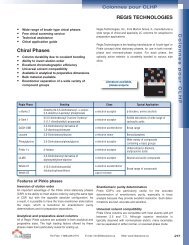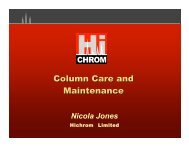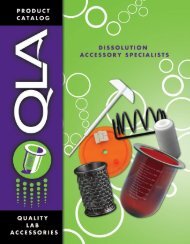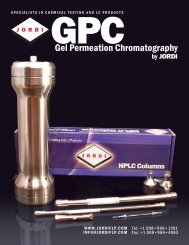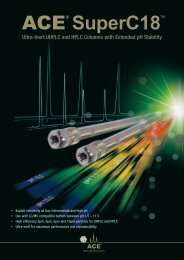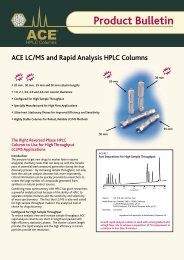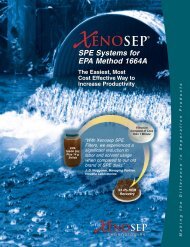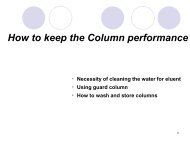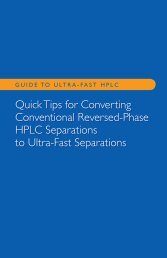Hypersil Gold Technical Guide - Canadian Life Science
Hypersil Gold Technical Guide - Canadian Life Science
Hypersil Gold Technical Guide - Canadian Life Science
Create successful ePaper yourself
Turn your PDF publications into a flip-book with our unique Google optimized e-Paper software.
FAHRGASTZUFRIEDENHEITONLINE: www.vor.atDie Internetseiten der Verkehrsverbünde bieten Ihnen vieleverschiedene Möglichkeiten, sich über Fahrpläne, Routen,Preise und Tickets zu informieren. Besonders begehrt undfrequentiert ist EFA, unsere elektronische Fahrplanauskunft.Sie kennen Ihr Ziel? EFA zeigt Ihnen den besten Weg!Einfach Start, Ziel und die gewünschten Haltestellen oderAdressen auswählen, Datum und Uhrzeit aussuchen - schonliefert Ihnen EFA die besten Verbindungen für Ihren Fahrtwunsch.In der “erweiterten Auskunft” können Sie zusätzlicheAbstimmungen genau nach Ihren Wünschen vornehmen underhalten so Ihre perfekt auf Sie abgestimmte Fahrtroute!Die übersichtlichen flächendeckenden Umgebungspläne mitStraßen und Haltestellen erleichtern Ihnen die Orientierung beider An- und Abreise. Auch wenn einmal ein Fußweg notwendigist, wird dieser am Plan für Sie dargestellt.HOTLINE: 0810 22 23 24Sie haben Fragen zu Fahrplan, Tickets oder Tarif? Unsere MitarbeiterInnenfreuen sich auf Ihren Anruf: Mo bis Fr von 7 - 20 Uhrund Sa von 7 - 14 Uhr. Zum Ortstarif aus allen Netzen.Besser unterwegs
1.9 µm <strong>Hypersil</strong> GOLD ColumnsSpeedThe opportunity to increase sample throughput has generally beencompromised by a trade-off between column dimensions and operationalparameters associated with system capability. To demonstratehow the use of smaller particles in this environment gives anadditional route to improve sample turnaround, a separation ofseven phenone compounds performed on a 200 x 2.1 mm, 5 µmcolumn was transferred to shorter columns packed with smallerparticles to reduce analysis time. The flow rate and gradient time wereadjusted to reflect the changes in column length and particle size.The 1.9 µm particles facilitate a decrease in run time from 6 to 0.5minutes, while maintaining baseline resolution of the seven phenones,as seen in Figure 7. In the top chromatogram, the column temperaturehas also been increased to achieve additional speed.SummaryNumerous experimental parameters can be manipulated to improvespeed, efficiency or resolution of a chromatographic separation.However, serious trade-offs existed to achieve both until theintroduction of sub-2 µm particles, such as <strong>Hypersil</strong> GOLD 1.9 µmcolumns. The exceptional range of optimal linear velocity that canbe achieved using sub-2 µm particles allows the use of high flowrates to reduce analysis time while maintaining chromatographicefficiency. In addition, the smaller particles allow for the reductionin column length while maintaining efficiency, providing furthergains in speed of analysis at high flow rates without exceeding thepressure limits of standard HPLC systems.<strong>Hypersil</strong> GOLDMobile Phase: A – H 2 O; B – ACNGradient:65 to 95% B in t gTemperature: 40 °CDetection:247 nm (0.1s rise time)Injection Volume: 0.2 µLUHPLC System: Accela Analytes:1. Acetophenone2. Propiophenone3. Butyrophenone4. Valerophenone5. Hexanophenone6. Heptanophenone7. Octanophenone50 x 2.1 mm, 1.9 µmFlow Rate: 1000 µL/mint g = 0.4 min; Temp.: 60 °CW = 1.8 s50 x 2.1 mm, 1.9 µmFlow Rate: 1000 µL/mint g = 0.4 minW = 1.8 s100 x 2.1 mm, 1.9 µmFlow Rate: 1000 µL/mint g = 0.7 minW = 2.4 s200 x 2.1 mm, 1.9 µmFlow Rate: 600 µL/mint g = 1.5 minW = 3.6 s200 x 2.1 mm, 3 µmFlow Rate: 400 µL/mint g = 2.3 minW = 5.4 s200 x 2.1 mm, 5 µmFlow Rate: 250 µL/mint g = 3.5 minW = 9.0 s6Figure 7: Effect of column length, particle size and operating conditions on run time and peak width at baseline (W).
1.9 µm <strong>Hypersil</strong> GOLD ColumnsDetector Sampling RateWith 1.9 µm particles, operating parameters can be optimized togive fast analysis. This results in narrow chromatographic peakswhich may be of the order of 1-2 seconds in width. It is important toscan the detector (whether it is UV or MS) fast enough to achieveoptimum peak definition, otherwise resolution, efficiency andanalytical accuracy will be compromised. This is illustrated inFigure 9, which illustrates a loss of resolution and peak heightwhen only five scan points cover the peak.Dwell VolumeThe HPLC pump dwell volume is extremely important when runninghigh speed applications using ballistic gradients, typical of highthroughput separations on small particle packed columns. This isbecause the pump dwell volume affects the time it takes for thegradient to reach the head of the column.If we consider a method using a flow rate of 0.4 mL/min anda fast gradient of 1 minute, the theoretical gradient reaches thecolumn immediately (Figure 10). A pump with a 65 µL dwell volume(such as used in the Thermo Scientific Accela Fast HPLC) will get thegradient onto the column in 9.75 seconds. A traditional quaternarypump with a dwell volume of 800 µL will take 2 minutes to get thegradient to the column. When running rapid gradients this is tooslow as can be seen on the example chromatogram.In Figure 10 A and B the same 2 minute gradient was run ona pump with a 800 µL dwell volume, and a pump with a 80 µL dwellvolume. The chromatograms are very different: for chromatogram A,it was necessary to introduce an isocratic hold at the end of the2 minutes gradient to allow elution of the analytes. In theseconditions the pump dwell volume can double the run time, andit also impacts on column re-equilibration at the end of the run.Figure 9: Effects of detector sampling rate on peak shape. With the use of1.9 µm particles, it is important that the detector scan rate is fast enough tomaintain peak definition. In this figure, there is a dramatic difference in peakshape when only five data points (slower scan rate) are acquired comparedto 45 data points (faster scan rate).<strong>Hypersil</strong> GOLDColumn: 1.9 µm, 50 x 2.1 mmMobile Phase: A: H 2 O + 0.1% Formic acidB: ACN + 0.1% Formic acidGradient: 5 to 100% B in 2 minFlow Rate: 0.55 mL/minTemperature: 25 °CDetection: UV @ 270 nmInjection Volume: 0.5 µLAnalytes:1. Sulphaguanidine2. Sulphamerazine3. Sulphamonomethoxine4. Sulphaquinoxaline• Theoretical gradient reaches the column at0 seconds• 65 µL dwell volume at 0.4 mL/min, gradientreaches the column at 9.75 seconds• 180 µL dwell volume at 0.4 mL/min, gradientreaches the column at 27 seconds• 800 µL dwell volume at 0.4 mL/min, gradientreaches the column at 120 secondsABFigure 10: The effects of pump dwell volume on the separation. When running rapid gradients it is important to utilize a pump with a small dwell volume.8
System PressureIn order to tune your assay to your HPLC system, remember that asthe particle size is reduced, resistance to flow increases, causingpressure drop to increase within the system. This is approximatedby the Equation 9 below:For the fastest results from small particle columns, you mustensure that your system can function reliably at higher operatingpressure. Figure 11 shows that the flow rates for optimum efficiency(taken from the van Deemter plot) can lie within the limits ofconventional HPLC systems, even for 1.9 µm particles.Pressure Drop (psi) ~ 250 L η F / d p2d c2(9)where L = Column Length (mm)η = Mobile Phase Viscosity (cP)F = Flow Rate (mL/min)d p = Particle Diameter (µm)d c = Column Internal Diameter (mm)This equation shows that the pressure drop across the columnvaries with:• The length of the column. Longer columns have higherpressure drops.• The ID of the column. Narrower columns have higherpressure drops.• The diameter of the particles packed within the column.The smaller the particles the higher the pressure drop. This is asquared relationship and has a significant effect.• The flow rate. A higher flow rate will result in a higherpressure drop.• The viscosity of the mobile phase. Higher viscosities willresult in higher pressure drops. Increased temperatures reducethe viscosity, enabling a higher flow rate to be used for anequivalent pressure drop.Figure 11: System pressure considerations with 1.9 µm particles. The shadedareas indicate typical system pressures at the optimum flow rates, measuredon a 20 mm length column.9
1.9 µm <strong>Hypersil</strong> GOLD ColumnsSection 3: Tips for Method TransferAs well as particle size, column dimensions can be scaled down toachieve faster separations. Care must be taken when transferring amethod to shorter columns with smaller particles to ensure operatingflow rate and gradient profiles are scaled to keep the assay profileconsistent. An understanding of some practical calculation routineshelp to achieve the scaling.Isocratic Method Transfer1) Adjust flow rate, keeping linear velocity constant between the original and new method.System 1 System 2Column 1: 100 x 4.6 mm, 5 µm Column 2: 100 x 2.1 mm, 1.9 µmFlow Rate 1: 1.0 mL/minFlow Rate 2: 0.55 mL/minF 1 – original flow rate (mL/min)d c1 – original column internal diameter (mm)d p1 – original column particle size (mm)F 2 = F 1 x (d c22 /d c12 ) x (d p1 /d p2 )F 2 – new flow rate (mL/min)d c2 – new column internal diameter (mm)d p2 – new column particle size (mm)Entering the column dimensions for both systems and the original flow rate results in a calculated flow rate of 0.55 mL/min for system 2. Transferring this method to a columnpacked with 1.9 µm particles gives a 4.8x increase in sensitivity and 2x increase in speed.<strong>Hypersil</strong> GOLDMobile Phase: H 2 O/ACN (50:50)+ 0.1% Formic acidTemperature: 25 °CDetection: UV @ 254 nmInjection Volume: 2 µLColumn: 100 x 4.6 mm, 5 µm Column: 100 x 2.1 mm, 1.9 µmAnalytes:1. Cortisone2. 11-α-hydroxyprogesterone3. 17-α-hydroxyprogesterone4. Progesterone4.8 x higher sensitivity; 2 x speedFigure 12: Isocratic method transfer to narrower ID column packed with smaller particles.2) Adjust injection volume.System 1 System 2Column 1: 100 x 4.6 mmColumn 2: 50 x 2.1 mmV i1 = 10 µL V i2 = 1 µLV i2 = V i1 x (d c22 x L 2 /d c12 x L 1 )V i1 – original injection volume (µL)d c1 – original column internal diameter (mm)L 1 – original column length (mm)V i2 – new injection volume (µL)d c2 – new column internal diameter (mm)L 2 – new column length (mm)Entering the column dimensions for both systems and the original injection volume results in an injection volume of 1 µL for system 2.10In practical terms it is often not possible to follow the equationexactly, due to sample constraints, but the chromatographer shouldbe aware that smaller columns packed with 1.9 µm particles willrequire a smaller injection volume.
Method Transfer for Increased ResolutionWhen transferring a method to a column packed with small particlesit is possible to optimize certain chromatographic parameters tofurther increase resolution for difficult separations in complexmatrices. In the example below, using the same analytes, the columnlength was maintained and the flow rate and column ID decreased.This results in a 13% increase in resolution between peaks 1 and 2,as shown in Figure 13.Method Transfer for Increased SpeedIf the analyte peaks are well separated and high throughput is themost important consideration for a method, it is possible to increasethe chromatographic speed by further reducing the column lengthand increasing the flow rate. In Figure 14, the calculated methodtransfer flow rate comes out at 0.55 mL/min. This and the shortercolumn used reduces the retention time for peak 4 from 416 secondsto 95 seconds. To obtain an even faster analysis, the separation hasbeen repeated on a shorter column with a higher flow rate, giving aretention time for peak 4 of 29 seconds. This is 14 times faster thanthe original method and underlines the power of small particles forfast analysis.<strong>Hypersil</strong> GOLDMobile Phase: H 2 O/ACN (50:50)+ 0.1% Formic acidTemperature: 25 °CDetection: UV @ 254 nmInjection Volume: 2 µLAnalytes:1. Cortisone2. 11-α-hydroxyprogesterone3. 17-α-hydroxyprogesterone4. Progesterone13% Higher ResolutionFigure 13: Isocratic method transfer to improve resolution.<strong>Hypersil</strong> GOLDMobile Phase: H 2 O/ACN (50:50)+ 0.1% Formic acidTemperature: 25 °CDetection: UV @ 254 nmInjection Volume: 2 µLAnalytes:1. Cortisone2. 11-α-hydroxyprogesterone3. 17-α-hydroxyprogesterone4. Progesterone14 x FasterFigure 14: Isocratic method transfer to improve speed. The column has been shortened further and the flow rate increased to 0.8 mL/min.11
1.9 µm <strong>Hypersil</strong> GOLD ColumnsGradient Method Transfer1) Adjust flow rate, keeping linear velocity constant between the original and new method.(in accordance with the isocratic method transfer equations on page 10)2) Adjust injection volume. (in accordance with the isocratic method transfer equations on page 10)3) Adjust gradient, keeping initial and final composition unchanged.System 1 System 2Column 1: 150 x 4.6 mmColumn 2: 50 x 2.1 mmGradient Profile 1 (t g1 ): 5 to 50% in 15 minsGradient Profile 2 (t g2 ): 5 to 50% in 5 minsColumn Volume: 1.7 mLColumn Volume: 0.11 mLt g2 = t g1 x (V 02 /V 01 ) x (F 1 /F 2 )t g1 – gradient time in original method (min)V 01 – original column volume (mL)F 1 – original flow rate (mL/min)t g2 – gradient time in new method (min)V 02 – new column volume (mL)F 2 – new flow rate (mL/min)Entering the column dimensions and flow rates for both systems and the original gradient gives a t g of 5 minutes for system 2.Column Volume (V 0 )V 0 = 0.68 x π x r 2 x LV 0 – column void volume (mL)L – column length (cm)r – column radius (cm)0.68 is the approximate fraction of the column volume occupied by mobile phase (for porous particles)In the example chromatograms on the following page (Figure 15),a gradient method for separating sulphonamides has beentransferred from a standard 5 µm analytical column to a shortercolumn containing 1.9 µm particles. This has been performedstepwise to illustrate the effect of each parameter change.For each step the gradient and flow rate have been scaledin accordance with the previous calculations. The finalchromatogram illustrates where the column has been furthershortened and the flow rate and gradient made even fasterto increase throughput.The table compares key parameters from the start and endmethods and shows that even under ultra fast conditions (thefinal gradient is 15 times faster than the starting gradient),baseline separation is still achieved. The peak heights aresimilar even though the injection volume is 10% of the startinginjection volume accentuating the increased sensitivityachieved using 1.9 µm particles.12
A<strong>Hypersil</strong> GOLDColumn: 150 x 4.6 mm, 5 µm (V = 1.7 mL)Gradient: 5 to 100% B in 15 minutesMobile Phase: A: H 2 O + 0.1% Formic acidB: ACN + 0.1% Formic acidTemperature: 25 °CDetection: UV @ 254 nmInjection Volume: 5 µLFlow Rate: 1 mL/minAnalytes:1. Sulphaguanidine2. Sulphamerazine3. Sulphamonomethoxine4. SulphaquinoxalineColumn: 100 x 4.6 mm, 5 µm (V = 1.1 mL)Gradient: 5 to 100% B in 10 minutesFlow Rate: 1 mL/minB150 x 4.6 mm, 5 µm 30 x 2.1 mm, 1.9 µmChromatogram A Chromatogram EPeak Width* (s) 9.0 4.213.2 3.610.2 3.011.4 2.4Resolution* 11.2 8.85.4 2.07.4 2.2Peak Height 236331 71764231151 139283220165 170483222985 135603* baselineColumn: 50 x 2.1 mm, 5 µm (V = 0.11 mL)Gradient: 5 to 100% B in 5 minutesFlow Rate: 0.2 mL/minCColumn: 50 x 2.1 mm, 1.9 µm (V = 0.11 mL)Gradient: 5 to 100% B in 2 minutesFlow Rate: 0.55 mL/minInjection Volume: 0.5 µLDColumn: 30 x 2.1 mm, 1.9 µm (V = 0.07 mL)Gradient: 5 to 100% B in 1 minutesFlow Rate: 0.7 mL/minInjection Volume: 0.5 µLECycle Time Reduced by 10 FoldFigure 15: Stepwise transfer of a gradient method to 1.9 µm <strong>Hypersil</strong> GOLD. In each step, the gradient and flow rate are scaled using the calculationspresented. In step 1, column length was reduced. Step 2 shows the effects of a reduction in column ID. In Step 3 particle size is reduced to 1.9 µm.In Step 4, the column length is decreased again, while the flow rate is increased.13
1.9 µm <strong>Hypersil</strong> GOLD ColumnsSection 4: Column Reproducibility<strong>Hypersil</strong> GOLD columns are exceptionally reproducible for reliablechromatography, column after column. This allows the user to beconfident that assays developed with <strong>Hypersil</strong> GOLD columns willbe robust and stable for the life of the assay, making them the idealchoice for new method development.Built on 30 years of experience in product development andmanufacturing of HPLC media and columns, Thermo Scientific<strong>Hypersil</strong> GOLD consumables continue upon their success with thedevelopment of a new state-of-the-art family of columns, based on1.9 µm particles, designed for improved chromatography. <strong>Hypersil</strong>GOLD columns are manufactured in ISO 9001:2000 accreditedlaboratories under strict protocols using a robust manufacturingprocedure and extensive quality control testing.To obtain the most accurate results when performing quantitativeanalysis it is important that key chromatographic parameters suchas retention time and peak area remain consistent.Figure 16: 1.9 µm <strong>Hypersil</strong> GOLD Batch Reproducibility. The capacity factorwas measured for a series of peaks across 5 separate batches of 1.9 µm<strong>Hypersil</strong> GOLD. The reproducible values provide the chromatographer withconfidence that analyte peaks will elute at the same time, every time.Figure 18: Batch Reproducibility with 1.9 µm <strong>Hypersil</strong> GOLD Columns. For allbatches, the tailing factor measured for a very basic analyte, is close tounity, highlighting the excellent symmetrical peak shape which ischaracteristic of all <strong>Hypersil</strong> GOLD columns.Figure 17: 1.9 µm <strong>Hypersil</strong> GOLD Column Reproducibility. 1.9 µm <strong>Hypersil</strong>GOLD columns show excellent reproducibility, column after column. In thisexample, the efficiency of 200 different columns is shown. Efficiency inexcess of 160,000 plates/m is consistently achieved, column after column.Figure 19: System Back Pressure with 1.9 µm <strong>Hypersil</strong> GOLD. The systemback pressure has been measured over eight separate columns at two flowrates. The minimal variation in column back pressure can only be achievedusing consistently well-packed stationary phase with a reproducible narrowparticle size distribution.14
Assay ReproducibilityThe analysis of a mixture of sulphonamides using 1.9 µm <strong>Hypersil</strong>GOLD column gives a linear response over a range of concentrationsbetween 25 and 250 ng/mL (Figure 20).The table shows excellent reproducibility for retention times(< 1% RSD) and peak area (< 2% RSD) over six injections. Thishighlights that accurate data can be obtained under fast chromatographicconditions, where peak widths might be as narrow as1-2 seconds.<strong>Hypersil</strong> GOLD, 1.9 µm, 50 x 2.1 mmMobile Phase: A: H 2 O + 0.1% Formic acidB: ACN + 0.1% Formic acidGradient: 5 to 100% B in 2 minFlow Rate: 0.55 mL/minTemperature: 25 °CDetection: UV @ 270 nmInjection Volume: 0.5 µLAnalytes:1. Sulphaguanidine2. Sulphamerazine3. Sulphamonomethoxine4. SulphaquinoxalineRt (min) Rt (min) Rt (min) Peak Area Peak Area Peak AreaMean STD RSD (%) Mean STD RSD (%)SulphaguanidineLevel 1 (25 ng/µL) 0.50 0.000 0.00 58066 1153 1.99Level 2 (50 ng/µL) 0.51 0.005 0.93 109285 920 0.84Level 3 (250 ng/µL) 0.51 0.004 0.73 545729 2962 0.54SulphamerazineLevel 1 (25 ng/µL) 1.06 0.005 0.47 76352 941 1.23Level 2 (50 ng/µL) 1.10 0.011 0.97 153414 2229 1.45Level 3 (250 ng/µL) 1.08 0.009 0.83 873540 11653 1.33SulphamonomethoxineLevel 1 (25 ng/µL) 1.19 0.005 0.42 107601 1389 1.29Level 2 (50 ng/µL) 1.23 0.010 0.78 182809 2954 1.62Level 3 (250 ng/µL) 1.22 0.011 0.83 859790 14827 1.72SulphaquinoxalineLevel 1 (25 ng/µL) 1.32 0.004 0.28 74714 1252 1.68Level 2 (50 ng/µL) 1.36 0.012 0.85 146760 2225 1.52Level 3 (250 ng/µL) 1.35 0.007 0.51 688423 10197 1.48Figure 20: Calibration Curves for Sulphonamides. 1.9 µm <strong>Hypersil</strong> GOLDcolumns produce a linear response over a range of concentrations.Ordering InformationDescription Particle Size Length (mm) 3.0 mm ID 2.1 mm ID 1.0 mm ID 320 µm ID<strong>Hypersil</strong> GOLD 1.9 µm 20 25002-023030 25002-022130 – –30 25002-033030 25002-032130 25002-031030 –50 25002-053030 25002-052130 25002-051030 25002-050365100 25002-103030 25002-102130 25002-101030 25002-100365200 – 25002-202130 – –<strong>Hypersil</strong> GOLD aQ 1.9 µm 20 25302-023030 25302-022130 – –30 25302-033030 25302-032130 25302-031030 –50 25302-053030 25302-052130 25302-051030 25302-050365100 25302-103030 25302-102130 25302-101030 25302-100365200 – 25302-202130 – –<strong>Hypersil</strong> GOLD PFP 1.9 µm 20 25402-023030 25402-022130 – –30 25402-033030 25402-032130 25402-031030 –50 25402-053030 25402-052130 25402-051030 25402-050365100 25402-103030 25402-102130 25402-101030 25402-100365200 – 25402-202130 – –Other custom column dimensions are available. Please call your local Customer Service for more information.15
Laboratory Solutions Backed by Worldwide Service and SupportTap our expertise throughout the life of your instrument. Thermo Scientific Servicesextends its support throughout our worldwide network of highly trained and certifiedengineers who are experts in laboratory technologies and applications. Put our teamof experts to work for you in a range of disciplines – from system installation, trainingand technical support, to complete asset management and regulatory complianceconsulting. Improve your productivity and lower the cost of instrument ownershipthrough our product support services. Maximize uptime while eliminating theuncontrollable cost of unplanned maintenance and repairs. When it’s time toenhance your system, we also offer certified parts and a range of accessories andconsumables suited to your application.To learn more about our products and comprehensive service offerings,visit us at www.thermo.com.In addition to these offices, ThermoFisher Scientific maintains a networkof representative organizationsthroughout the world.Australia+61 2 8844 9500 • analyze.au@thermo.comAustria+43 1 333 50340 • analyze.at@thermo.comBelgium+32 2 482 30 30 • analyze.be@thermo.comCanada+1 800 532 4752 • analyze.ca@thermo.comChina+86 10 5850 3588 • analyze.cn@thermo.comDenmark+45 70 23 62 60 • analyze.dk@thermo.comFrance+33 1 60 92 48 00 • analyze.fr@thermo.comGermany+49 6103 408 1014 • analyze.de@thermo.comIndia+91 22 6742 9434 • analyze.in@thermo.comItaly+39 02 950 591 • analyze.it@thermo.comJapan+81 45 453 9100 • analyze.jp@thermo.comLatin America+1 608 276 5659 • analyze.la@thermo.comNetherlands+31 76 587 98 88 • analyze.nl@thermo.comSouth Africa+27 11 570 1840 • analyze.sa@thermo.comSpain+34 91 657 4930 • analyze.es@thermo.comSweden / Norway / Finland+46 8 556 468 00 • analyze.se@thermo.comSwitzerland+41 61 48784 00 • analyze.ch@thermo.comUK+44 1442 233555 • analyze.uk@thermo.comUSA+1 800 532 4752 • analyze.us@thermo.comwww.thermo.com/columnsISO 9001:2000 FM 76231Thermo Electron Corporation,Bellefonte, PA is ISO Certified.Thermo <strong>Hypersil</strong> Ltd.,Runcorn, UK is ISO Certified.Visit our New Chromatography Resource Center @ www.thermo.com/columnsFor <strong>Technical</strong> Support:North AmericaT +1 800 437 2999E techsupport.analyze.us@thermo.comAfrica, Asia, Europe, Latin America and Middle EastT +44 (0) 1928 581000E techsupport.columns@thermo.com©2007 Thermo Fisher Scientific Inc. All rights reserved.All trademarks are the property of Thermo FisherScientific Inc. and its subsidiaries.Specifications, terms and pricing are subject to change.Not all products are available in all countries. Pleaseconsult your local sales representative for details.TG20338_E 06/07M



